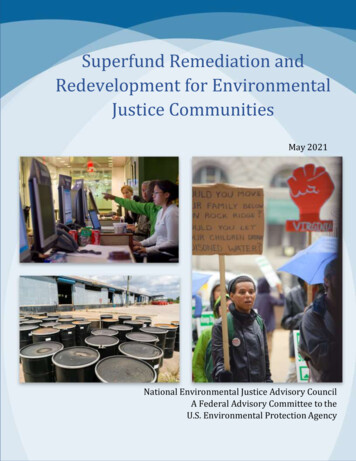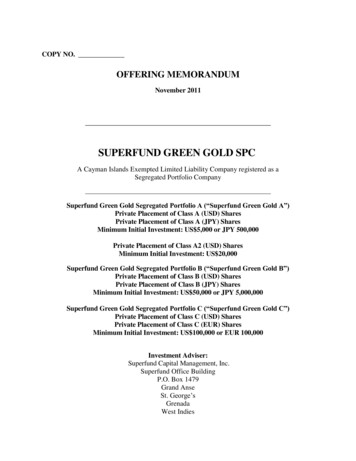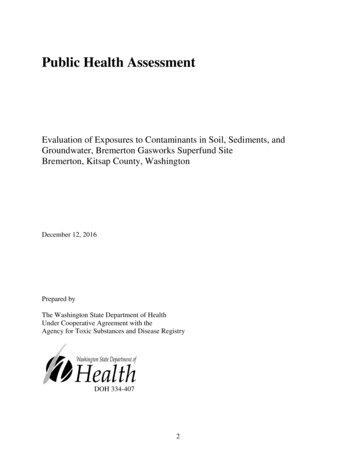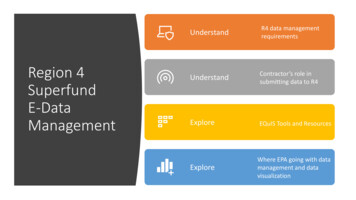
Transcription
Superfund Remediation andRedevelopment for EnvironmentalJustice CommunitiesMay 2021National Environmental Justice Advisory CouncilA Federal Advisory Committee to theU.S. Environmental Protection Agency
ACKNOWLEDGEMENTSThe National Environmental Justice Advisory Council (NEJAC) acknowledges the efforts of the NEJACSuperfund Task Force Work Group in preparing the initial draft of this report and especially theleadership of Michael Tilchin in shepherding the group and this report throughout. The NEJAC alsoacknowledges the stakeholders and community members who participated in the Work Group’sdeliberation by providing public comments. In addition, the Work Group’s efforts were supported by theU.S. Environmental Protection Agency (EPA) staff, notably, Tai Lung.DISCLAIMERThis report of recommendations has been written as part of the activities of the NEJAC, a public advisorycommittee providing independent advice and recommendations on the issue of environmental justice tothe Administrator and other officials of the EPA. In addition, the materials, opinions, findings,recommendations, and conclusions expressed herein, and in any study or other source referencedherein, should not be construed as adopted or endorsed by any organization with which any WorkGroup member is affiliated. This report has not been reviewed for approval by the EPA, and hence, itscontents and recommendations do not necessarily represent the views and the policies of the Agency,nor of other agencies in the Executive Branch of the Federal government.
NATIONAL ENVIRONMENTAL JUSTICE ADVISORY COUNCIL Sylvia Orduño, Michigan Welfare Rights Organization (NEJAC Chair)Na’Taki Osborne Jelks, West Atlanta Watershed Alliance (NEJAC Vice-Chair)Michael Tilchin, Jacobs Engineering (NEJAC Vice-Chair)April Karen Baptiste, Colgate UniversityJoy Britt, Alaska Native Tribal Health ConsortiumCemelli De Aztlan, El Paso Equal Voice NetworkJohn Doyle, Little Big Horn CollegeJabari O. Edwards, J5 GBL, LLCJan Fritz, University of CincinnatiVenu Ghanta, Duke EnergyRita Harris, Sierra ClubCheryl Johnson, People for Community RecoveryVirginia King, Marathon Petroleum LPMildred McClain, Citizens for Environmental Justice and Harambee House, Inc.Melissa McGee-Collier, Mississippi Department of Environmental QualityRichard Moore, Los Jardines InstituteAyako Nagano, Common VisionJeremy F. Orr, Natural Resources Defense CouncilBenjamin J. Pauli, Kettering UniversityMillicent Piazza, Washington State Department of EcologyDennis Randolph, City of KalamazooJerome Shabazz, JASTECH Development Services Inc. & Overbrook Environmental EducationCenterJacqueline Shirley, Rural Community Assistance CorporationKaren Sprayberry, South Carolina Department of Health and Environmental ControlPamela Talley, Lewis Place Historical Preservation, Inc.Hermila Trevino-Sauceda, Alianza Nacional de CampesinasSandra Whitehead, George Washington UniversitySacoby Wilson, University of MarylandKelly C. Wright, Shoshone Bannock TribesKaren L. Martin, Designated Federal Officer, US EPA Office of Environmental Justice
SUPERFUND WORKING GROUP MEMBERS Charlie Chase, University of Colorado-Boulder (Work Group Co-Chair)Michael Tilchin*, Jacobs Engineering (Work Group Chair)Kelly C. Wright*, Shoshone Bannock Tribes (Work Group Co-Chair)Rosanne Albright, City of PhoenixAndrea Bain, US Environmental Protection AgencyMiles Ballogg, CardnoJabari O. Edwards*, J5 GBL, LLCDaniel B. French, Brownfields Listing LLCJan Fritz*, University of CincinnatiSusan Hanson, Independent ConsultantRita Harris*, Sierra ClubDeclan Hayes, US Environmental Protection AgencyCharles Howland, Curtis, Mallet-Prevost, Colt & Mosle LLPLena Kim Adams, US Environmental Protection AgencyJason Lichtstein, Akerman LLPAngelo Logan, Moving Forward NetworkEllen Manges, US Environmental Protection AgencyKaren L. Martin, US Environmental Protection AgencyMelissa McGee-Collier*, Mississippi Department of Environmental QualitySylvia Orduno*, Michigan Welfare Rights OrganizationSuzi Ruhl, US Environmental Protection AgencyKaren Sprayberry*, South Carolina Department of Health and Environmental ControlMatthew Tejada, US Environmental Protection AgencyDavid Templeton, Anchor QEA LLCHermila Trevino-Sauceda*, Alianza Nacional de CampesinasAudrie Washington, US Environmental Protection AgencySandra Whitehead*, George Washington UniversitySacoby Wilson*, University of MarylandDewey F. Youngerman, Continental Maritime of San DiegoTai Lung, Designated Federal Officer, US EPA Office of Environmental JusticeThe * denotes NEJAC members
NATIONAL ENVIRONMENTAL JUSTICE ADVISORYCOUNCILMembers:Sylvia Marie Orduño,ChairNa’Taki OsborneJelks,Vice-ChairMichael TilchinVice-ChairApril Baptiste, PhDJoy BrittCemelli de AztlanJohn DoyleJabari O. EdwardsJan Fritz, PhDVenu GhantaRita HarrisCheryl JohnsonVirginia KingMildred McClainMelissa McGeeCollierRichard MooreAyako NaganoJeremy F. OrrPauli BenjaminMillie PiazzaDennis RandolphJerome ShabazzJacqueline ShirleyKaren SprayberryPamela TalleyHermila TrevinoSaucedaSandra Whitehead,PhDSacoby Wilson, PhDKelly C. WrightMay 6, 2021Michael S. Regan, AdministratorU.S. Environmental Protection Agency1200 Pennsylvania Avenue, NWWashington, D.C. 20460Dear Administrator Regan:The National Environmental Justice Advisory Council (NEJAC) is pleased to submit thisreport titled Superfund Remediation and Redevelopment for Environmental JusticeCommunities. The NEJAC developed this report in response to a charge issued inNovember 2018 from the EPA Superfund Task Force (SFTF) to help integrateenvironmental justice into the cleanup and redevelopment of Superfund and othercontaminated sites. The overall goal of the charge is to identify barriers, developsolutions, and recommend best practices for improving our ability to achieve clean-upsof Superfund sites more quickly and with better outcomes for local communities; takingcentral consideration of the unique burdens and vulnerabilities of environmental justicepopulations living in and around Superfund sites. EPA’s charge to NEJAC consisted of fivequestions: What are specific ways in which the NEJAC, EPA, and other relevant stakeholders canfacilitate strong, strategic relationships with stakeholders to facilitate effectivecleanups and site reuse, and equitable decision-making throughout the entireSuperfund (SF) process? What does NEJAC believe should be done to facilitate effective, efficient, andconsistent decision-making regarding remediation and redevelopment of NationalPriorities List (NPL) sites? Can the NEJAC provide examples of case studies and models – Superfund and nonSuperfund alike – that illustrate best practices and lessons learned (cleanup,redevelopment, risk communication, federal initiatives) which can inform ways toelevate equity in Superfund cleanup and redevelopment, to ensure all have a voice inEPA decisions? Which additional resources (e.g. water infrastructure investment, job creation) can berealized to support reuse and redevelopment of remediated Superfund sites fromother sources? Does the NEJAC propose any additional issues related to the clean-up andredevelopment of Superfund sites that are not captured in the questions above?To address this charge, NEJAC established a Superfund Working Group (SWG) composed of 30 membersfrom diverse backgrounds in academia, financial, legal, brownfields, remediation, federal, state, localand tribal government, and community-based organizations. Building upon the research, analysis, andcase study examples provided by the SWG, the NEJAC developed a broad set of strategies andrecommendations that NEJAC believes will lead to a more effective Superfund program, cleaning upsites and improving the quality of life in environmental justice and other communities impacted bycontaminated hazardous waste sites.A Federal Advisory Committee to the U.S. Environmental Protection Agency
NATIONAL ENVIRONMENTAL JUSTICE ADVISORYCOUNCILThe strategies and recommendations in this report describe steps the Superfund program can take toimprove performance and achieve better outcomes for environmental justice communities. Those stepscombine to form several overarching themes and key findings: Remediation and Redevelopment: Success is best achieved when both remediationand reuse/redevelopment efforts align with the impacted community’s vision. EPAshould engage the impacted community in establishing an end-state vision for the sitein the early planning stage.Community concerns, challenges and opportunities: Early community engagement iscrucial, and the emphasis of the early engagement efforts should be on listening andseeking to genuinely understand community concerns.EPA Superfund Role: Expand the role of Superfund to purposefully facilitate progresstoward meeting broader community needs. This will require an expansion of programobjectives, performance expectations, and a shift in program culture.Consistency: Consistent application of contaminated site policies and practices buildscommunity trust and leads to a higher level and more sustained communityparticipation.Strengthen community voices in decision-making: Expanding access to informationand supporting community engagement in decision-making levels the playing field andfosters community consensus. Without enabling impacted communities to directlyengage in the decision-making process, environmental justice will not be achieved inthe Superfund program.The report is organized around seven strategies:1. Implement more intensive community engagement practices at Superfund sites2. Revise and update guidance and strengthen policies focused on understanding and respondingto community needs3. Update, improve, and expand training that reaches impacted communities, EPA staff, and statestaff4. Elevate future use planning as a core element of the Superfund process5. Leverage redevelopment and reuse as a catalyst for innovation and accelerated cleanup6. Ensure equity in all aspects of the Superfund program7. Increase access to resources for impacted communitiesEach strategy is expanded into recommendations. Many of the recommendations describeimplementing actions and the intended outcomes - a new “end state” for the Superfund program thatwill result in a more effective program, protective of human health and the environment, and enablingthe creation of assets that improve the quality of life and expand opportunity, closely aligned with thecommunity’s vision. Taken together, we believe the implementation of these strategies andrecommendations will have a positive, transformative impact on EJ communities and the Superfundprogram as a whole.Thank you for this opportunity to provide recommendations for enhancing Superfund remediation andredevelopment in environmental justice communities. NEJAC strongly supports the administration’scommitment embodied in Executive Orders 14008 and 13985: to make environmental justice a part ofA Federal Advisory Committee to the U.S. Environmental Protection Agency
NATIONAL ENVIRONMENTAL JUSTICE ADVISORYCOUNCILthe mission of every agency, and to develop programs, policies, and to be intentional about infusingequity and racial justice in all aspects of what the federal government does. We believe therecommendations for the Superfund program in this report are in full alignment and offer a blueprint fortranslating those commitments into positive action. We look forward to hearing the Agency’s response.Sincerely,Sylvia Orduno, Chaircc:NEJAC MembersBarry Breen, EPA Acting Assistant Administrator for the Office of Land and EmergencyManagement (OLEM)Carlton Waterhouse, EPA Deputy Assistant Administrator for the OLEMVictoria Arroyo, EPA Associate Administrator for the Office of PolicyLarry Duchand, Director, Office of Superfund Remediation and Technology InnovationMatthew Tejada, Director, EPA Office of Environmental Justice (OEJ)Karen Martin, Designated Federal Officer, National Environmental Justice Advisory Council, OEJTai Lung, Designated Federal Officer, Superfund Task Force Working Group, OEJA Federal Advisory Committee to the U.S. Environmental Protection Agency
Table of ContentsExecutive Summary. 10Strategies and Recommendations . 10Introduction and Background . 15Guiding Principles . 15Background . 16Organization of this Report. 17Strategy 1: Implement more intensive community engagement practices at Superfund sites . 19Recommendations aligned with Strategy 1 . 20Expected Outcomes (and Accountabilities) . 24Case Study: Memphis Defense Depot. 25Strategy 2: Revise and update guidance and strengthen policies focused on understanding andresponding to community needs . 27Recommendations aligned with Strategy 2 . 27Expected Outcomes (and Accountabilities) . 29Case Study: Eastern Michaud Flats . 31Strategy 3: Update, improve, and expand training that reaches impacted communities, EPA staff, andstate staff . 34Recommendations aligned with Strategy 3 . 34Expected Outcomes and (Accountabilities) . 38Case Study: Tar Creek . 39Strategy 4: Elevate future use planning as a core element of the Superfund process . 42Recommendations aligned with Strategy 4 . 42Expected Outcomes (and Accountabilities) . 45Case Study: Harvest Hope Park . 46Strategy 5: Leverage redevelopment and reuse as a catalyst for innovation and accelerated cleanup . 48Recommendations aligned with Strategy 5 . 48Expected Outcomes (and Accountabilities) . 50Case Study: Menomonee Valley Industrial Center . 51Strategy 6: Ensure equity in all aspects of the Superfund program. 55
Recommendations aligned with Strategy 6 . 56Expected Outcomes (and Accountabilities) . 59Case Study: USS Lead . 60Strategy 7: Increase Access to Resources for Impacted Communities . 63Recommendations aligned with Strategy 7 . 66Expected Outcomes (and Accountabilities) . 70Case Study: 5th Street & Buckeye Road . 71Additional issues of concern and areas of opportunity related to the Superfund program . 74APPENDICESAppendix A: . 78Charge to the National Environmental Justice Advisory Council on Superfund Remediation andRedevelopment for EJ Communities. 78Charge Questions . 80Appendix B . 82Concentric, Community-Centered Outreach to Stakeholders and Community Resources. 82Appendix C . 83Conceptual Case Study Summary Template/Data Fields . 83Appendix D . 84Elements of Inclusive Market-Based Studies . 84Appendix E . 85Resources and EJ Needs Matrix . 85
Superfund Remediation and Redevelopment for Environmental Justice CommunitiesExecutive SummaryIn 2018, the National Environmental Justice Advisory Council (NEJAC) received a charge (Appendix A)from the EPA Superfund Task Force (SFTF) to help integrate environmental justice into the cleanup andredevelopment of Superfund and other contaminated sites. The overall goal of the charge is to providerecommendations to the EPA Administrator that will identify barriers, solutions, and best practices forimproving our ability to achieve clean-ups of Superfund sites more quickly and with better outcomes forlocal communities, taking central consideration of the unique burdens and vulnerabilities ofenvironmental justice populations living in and around Superfund sites.To address this charge, NEJAC established the Superfund Working Group (SWG) composed of 30members from diverse backgrounds in academia, financial, legal, brownfields, remediation, federal,state, local and tribal government, and community-based organizations. An interim report was issued bythe SWG in February, 20201. NEJAC’s final report, Superfund Remediation and Redevelopment forEnvironmental Justice Communities, includes a broad set of strategies and recommendations that NEJACbelieves will lead to a more effective Superfund program, cleaning up sites and improving the quality oflife in environmental justice and other communities impacted by contaminated hazardous waste sites.Strategies and RecommendationsThe strategies and recommendations in this report have the potential to move the Superfund programin a positive direction, integrating cleanup more closely with redevelopment and other beneficial uses,with both the cleanup and reuse aligned with the community’s needs and vision. Table ES-1 summarizesthe strategies and recommendations in this report.Many of the recommendations in this report would be modifications to current practices and processeswithin the Superfund program, where greater attention and resources would benefit the Superfundprogram, especially in EJ communities. Other recommendations represent innovations to the existingprogram. The actions contained in these “innovation” recommendations are not, to NEJAC’s knowledge,current practices, but we believe these can be readily implemented within the existing program. Severalrecommendations are for new programs to be designed, piloted and, once assessed and optimized,broadly implemented within Superfund, OLEM, or potentially at an Agency-wide scale. Therecommendations in Table ES-1 are highlighted according to these implementation categories: Elevating and Expanding Current Components of the Superfund Program aInnovative Superfund Initiatives and Collaborations bNew Programs within Superfund, OLEM, or Agency-Wide 8/documents/nejac superfund working group phase 1 report february 2020.pdfPage 10
Superfund Remediation and Redevelopment for Environmental Justice CommunitiesTaken together, we believe the implementation of these strategies and recommendations will have apositive and transformative impact on EJ communities and the Superfund program as a whole.While implementation of these strategies and recommendations will require additional resources, mostof the recommendations in this report do not have a significant impact on how the Superfund programis funded. However, the resources needed to make the program more responsive and effective in EJcommunities are superimposed on a program beset by underfunding. As clear evidence, there is agrowing backlog of sites that are ready to be cleaned up, but the work to protect communities is slowedor delayed indefinitely due to insufficient program funding2,3. The opportunities to make Superfundmore effective for EJ communities is by no means solely a matter of funding, but clearly there is afunding gap that needs to be addressed if NEJAC’s vision for the Superfund program is to be achieved.Table ES-1: Summary of Strategies and Recommendations*StrategiesRecommendationsStrategy 1: Implement moreintensive communityengagement practices atSuperfund sitesRecommendation 1.1 b: Identify and list Superfund sites impacting EJ communitiesRecommendation 1.2 b: Support and fund an ombudsperson role whoseresponsibilities would include improving community access to information andamplifying community voices in decision makingRecommendation 1.3 a: Strengthen and standardize the use of EPA’s successfulcommunity engagement tools and resourcesRecommendation 1.4 a: Engage local government early and regularly throughoutthe cleanup processRecommendation 1.5 a: Improve EPA and state staff ability to address riskcommunication at Superfund sites through increased resources, training, andguidance2Environmental Protection Network, Resetting the Course of EPA. August 20203Katherine Probst, NYU Law, Looking Back to Move Forward, Chapter 6, Superfund at 40: Unfulfilled Expectation.November 2020Page 11
Superfund Remediation and Redevelopment for Environmental Justice CommunitiesStrategy 2: Revise andupdate guidance andstrengthen policies focusedon understanding andresponding to communityneedsRecommendation 2.1 a: Develop a program-level Decision-Making EngagementGuidance aimed at more substantive and consistent involvement of impactedpopulationsRecommendation 2.2 a: Develop and issue guidance on using an ImpactedCommunity Centric/Concentric Circle Approach to Stakeholder EngagementRecommendation 2.3 b: Develop and issue revised guidance (and training) onremedy enhancement and betterment, as an update to OSWER Directive 9200.3110Recommendation 2.4 b: Establish and maintain a Case Study Repository, withstructured data collection and search capabilitiesRecommendation 2.5 b: Establish/promote “Communities of Practice” amongRPMs structured around technologies, site types, or other knowledge categoriesfor sharing best practicesStrategy 3: Update,improve, and expandtraining that reaches theimpacted communities, EPAstaff, and state staffRecommendation 3.1 a: Hold in-person and on-line training in the impactedcommunities on the relevant issues prior to the start of the remediation to givelocal stakeholders a basic understanding of the Superfund process, technologiesassociated with the remediation, and associated impactsRecommendation 3.2 a: Increase funding and expand community access to EPAtraining resources and toolsRecommendation 3.3 b: Create and fund a core team of dedicated Superfundcommunity training specialistsRecommendation 3.4 a: Update/enhance EPA’s internal training on communityengagement for staff working in communities around Superfund sitesRecommendation 3.5 a: Provide community engagement mentoring for EPA staffRecommendation 3.6 b: Provide State Superfund staff broader access to EPAtraining and resourcesStrategy 4: Elevate futureuse planning as a coreelement of the SuperfundprocessRecommendation 4.1 c: Develop and fund a Superfund Community-Based ReuseArea-Wide Planning Grant Program and implement an SCBR-AWP pilot project todevelop a proof of conceptRecommendation 4.2 b: Conduct a needs assessment combined with end statevisioning with the impacted community as a routine and early step in theSuperfund processRecommendation 4.3 a: Expand the size and scope of the SuperfundRedevelopment Initiative to help communities in the process of planning for thebeneficial reuse of Superfund sitesPage 12
Superfund Remediation and Redevelopment for Environmental Justice CommunitiesStrategy 5: Leverageredevelopment and reuseas a catalyst for innovationand accelerated cleanupRecommendation 5.1 b: Establish a Remediation and Redevelopment “InnovationIncubator” within EPA focused on leveraging redevelopment and reuse as acatalyst for effective, accelerated cleanupRecommendation 5.2 b: Assign a TIFSD “project advisor” to facilitate RPMs’ accessto technology expertise in order to promote innovation, adaptive management,and strategic risk-taking where innovative approaches may have significantbenefitsRecommendation 5.3 b: Expand the use of community-driven Health ImpactAssessments (HIA) as needs assessment and business planning toolsRecommendation 5.4 c: Re-institute the Community Action for a RenewedEnvironment grant programStrategy 6: Ensure equity inall aspects of the SuperfundprogramRecommendation 6.1 c: Establish a Superfund Equity Pilot Program for impactedcommunities addressing contaminated site remediation and redevelopmentRecommendation 6.2 c: Scale from a Superfund Equity Pilot to an establishedEquity ProgramRecommendation 6.3 c: Develop a Budget Equity Tool and build in equity as a keycomponent of EPA budgeting and financing at Superfund sitesRecommendation 6.4 b: Set site-specific goals for the percentage of EPA clean upspending that directly supports the impacted communities and publicly trackperformance toward meeting these goalsRecommendation 6.5 c: Establish a workforce social enterprise demonstrationprojectStrategy 7: Increase accessto resources for impactedcommunitiesRecommendation 7.1 a: Expand availability and improve accessibility of EPAresources for impacted populations at Superfund sitesRecommendation 7.2 b: Develop and implement proactive measures thatminimize the displacement of long-time community residents due to gentrificationand foster redevelopment that is beneficial to the communityRecommendation 7.3 c: Form EPA cross-department partnerships to increaseaccess to resources for impacted populationsRecommendation 7.4 b: Increase access to funding for impacted communities byimproving the funding/grant management process that is need basedRecommendation 7.5 c: Form federal government partnerships to increase accessto resources for communities impacted by Superfund sitesRecommendation 7.6 b: Develop a roster of potentially interested national,regional and local foundations and convene a community of practice betweenthese foundations and impacted communitiesRecommendation 7.7 b: Foster engagement of financial institutions in supportingrevitalization through community EJ developersRecommendation 7.8 a: Increase program funding to address the backlog ofunfunded cleanups in EJ communities* Implementation Categories: Elevating and Expanding Current Components of the Superfund Program aPage 13
Superfund Remediation and Redevelopment for Environmental Justice Communities Innovative Superfund Initiatives and Collaborations bNew Programs within Superfund, OLEM, or Agency-Wide cPage 14
Superfund Remediation and Redevelopment for Environmental Justice CommunitiesIntroduction and BackgroundThis report, Superfund Remediation and Redevelopment for Environmental Justice Communities, has itsorigin in the work of the Superfund Task Force (SFTF)4. The SFTF, composed of over 100 EPA careeremployees, was commissioned on May 22, 2017, to provide recommendations on how the Agency canrestructure the cleanup process, realign incentives of all involved parties to promote expeditiousremediation, reduce the burden on cooperating parties, incentivize parties to remediate sites,encourage private investment in cleanups of sites, and promote the revitalization of properties acrossthe country. On July 25, 2017, the EPA Superfund Task Force R
SUPERFUND WORKING GROUP MEMBERS Charlie Chase, University of Colorado-Boulder (Work Group Co-Chair) Michael Tilchin*, Jacobs Engineering (Work Group Chair) Kelly C. Wright*, Shoshone Bannock Tribes (Work Group Co-Chair) Rosanne Albright, City of Phoenix Andrea Bain, US Environmental Protection Agency Miles Ballogg, Cardno Jabari O. Edwards*, J5 GBL, LLC










